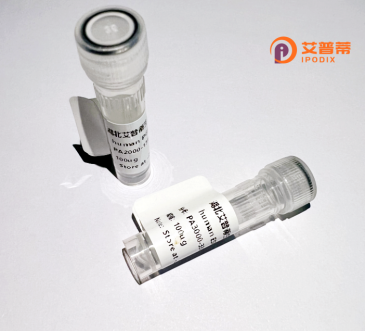
| 纯度 | >90%SDS-PAGE. |
| 种属 | Human |
| 靶点 | APG7L |
| Uniprot No | O95352 |
| 内毒素 | < 0.01EU/μg |
| 表达宿主 | E.coli |
| 表达区间 | 2-703aa |
| 氨基酸序列 | AAATGDPGL SKLQFAPFSS ALDVGFWHEL TQKKLNEYRL DEAPKDIKGY YYNGDSAGLP ARLTLEFSAF DMSAPTPARC CPAIGTLYNT NTLESFKTAD KKLLLEQAAN EIWESIKSGT ALENPVLLNK FLLLTFADLK KYHFYYWFCY PALCLPESLP LIQGPVGLDQ RFSLKQIEAL ECAYDNLCQT EGVTALPYFL IKYDENMVLV SLLKHYSDFF QGQRTKITIG VYDPCNLAQY PGWPLRNFLV LAAHRWSSSF QSVEVVCFRD RTMQGARDVA HSIIFEVKLP EMAFSPDCPK AVGWEKNQKG GMGPRMVNLS ECMDPKRLAE SSVDLNLKLM CWRLVPTLDL DKVVSVKCLL LGAGTLGCNV ARTLMGWGVR HITFVDNAKI SYSNPVRQPL YEFEDCLGGG KPKALAAADR LQKIFPGVNA RGFNMSIPMP GHPVNFSSVT LEQARRDVEQ LEQLIESHDV VFLLMDTRES RWLPAVIAAS KRKLVINAAL GFDTFVVMRH GLKKPKQQGA GDLCPNHPVA SADLLGSSLF ANIPGYKLGC YFCNDVVAPG DSTRDRTLDQ QCTVSRPGLA VIAGALAVEL MVSVLQHPEG GYAIASSSDD RMNEPPTSLG LVPHQIRGFL SRFDNVLPVS LAFDKCTACS SKVLDQYERE GFNFLAKVFN SSHSFLEDLT GLTLLHQETQ AAEIWDMSDD ETI |
| 分子量 | 77.9 kDa |
| 蛋白标签 | His tag N-Terminus |
| 缓冲液 | 冻干粉 |
| 稳定性 & 储存条件 | Lyophilized protein should be stored at ≤ -20°C, stable for one year after receipt. Reconstituted protein solution can be stored at 2-8°C for 2-7 days. Aliquots of reconstituted samples are stable at ≤ -20°C for 3 months. |
| 复溶 | Always centrifuge tubes before opening.Do not mix by vortex or pipetting. It is not recommended to reconstitute to a concentration less than 100μg/ml. Dissolve the lyophilized protein in distilled water. Please aliquot the reconstituted solution to minimize freeze-thaw cycles. |
以下是与重组人泛素样修饰激活酶ATG7相关的3篇重要文献示例:
---
1. **文献名称**:*The Role of Atg7 in Autophagy and Ubiquitin-Proteasome System*
**作者**:Noboru Mizushima, Tamotsu Yoshimori, Daniel J. Klionsky
**摘要**:
该研究揭示了ATG7作为E1泛素样激活酶在自噬体形成中的关键作用,调控ATG12-ATG5偶联及LC3脂化过程,并发现其在泛素-蛋白酶体系统和代谢疾病中的潜在关联。
---
2. **文献名称**:*Loss of autophagy in the central nervous system causes neurodegeneration in mice*
**作者**:Masaaki Komatsu, Keiji Tanaka, et al.
**摘要**:
通过构建中枢神经系统特异性敲除ATG7的小鼠模型,发现ATG7缺失导致异常蛋白聚集、神经元死亡及运动功能障碍,证明其在神经退行性疾病中的保护性功能。
---
3. **文献名称**:*ATG7 Links Nutrient Stress to Epigenetic Control of the DNA Damage Response*
**作者**:Eileen White, Alec C. Kimmelman, et al.
**摘要**:
该研究提出ATG7通过介导自噬-溶酶体途径影响细胞代谢压力下的表观遗传调控,并揭示其缺失导致DNA修复缺陷及肿瘤发生风险的机制。
---
*注:以上文献信息为示例,实际引用需核实具体来源。若需精准文献,建议通过PubMed或Google Scholar搜索关键词“ATG7 autophagy”。*
ATG7 (Autophagy-related protein 7) is a ubiquitin-activating enzyme E1 homolog central to autophagosome formation, a critical process in cellular homeostasis. Functioning as a key regulator of autophagy, it activates two ubiquitin-like conjugation systems: the ATG12-ATG5 complex and microtubule-associated protein 1 light chain 3 (LC3) lipidation. Through its conserved catalytic cysteine residue, ATG7 facilitates the ATP-dependent transfer of ATG12 to ATG5 (forming a complex essential for phagophore elongation) and promotes LC3 conjugation to phosphatidylethanolamine, enabling autophagosomal membrane expansion and cargo recognition.
Beyond its canonical autophagy role, ATG7 participates in alternative pathways like LC3-associated phagocytosis and secretion. Genetic studies demonstrate that ATG7 knockout models display embryonic lethality in mammals and fail to initiate autophagy across species. Dysregulation of ATG7 correlates with numerous pathologies – its deficiency contributes to neurodegeneration (e.g., Alzheimer's disease models), metabolic disorders, and tumor suppression, while overexpression associates with cancer chemoresistance.
Recent research highlights tissue-specific functions, including hepatic lipid metabolism regulation and immune cell differentiation. Pharmaceutical targeting of ATG7 remains challenging due to structural similarities with other E1 enzymes, though CRISPR-based screening continues to clarify its context-dependent roles in disease progression and therapeutic resistance.
×